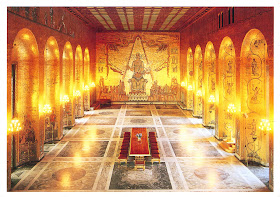 |
| 0722 Stockholm City Hall |
Posted on 06.07.2013, 20.07.2013
Located on the eastern tip of Kungsholmen island, Stockholm City Hall (Stadshuset in Swedish) is the building of the Municipal Council and houses offices and conference rooms as well as ceremonial halls, and the luxury restaurant Stadshuskällaren. Erected between 1911 and 1923 after the projects of Ragnar Östberg, which have undergone many changes, it was carried out by craftsmen using traditional techniques. Were used nearly eight million dark red bricks, called munktegel (monks's brick) because of their traditional use in the construction of monasteries and churches.
 |
| 0756 Stockholm City Hall - interior |
The building follows a roughly rectangular plan, being built around two open spaces, a piazza called Borgargården on the eastern side, and the Blue Hall (Blå hallen) to the west. The Blue Hall, named so even it hasn't blue decorations, is known as the dining hall used for the banquet held after the annual Nobel Prize award ceremony. After the 1,300 guests have finished dining, they move upstairs to the Stadshus’s most jaw-dropping room, the shimmering Golden Hall (Gyllene Salen - in the second postcard), where 19 million gold mosaic tiles decorate the walls.
Made after the sketches of the artist Einar Forseth, the mosaics shows allegorical events and people from Sweden's history of Byzantine-inspired (regarded by contemporaries ultra-modern as style), and were executed by the berliner firm Puhl & Wagner Gottfried Heinersdorff, after nine years of negotiations. A sumptuous image of Mälardrottningen (the Queen of the Lake Mälar), the symbol of Stockholm, occupies the entire north wall of the fund and is the room's central motif. She holds in hands the scepter and the crown, and in lap Stockholm City Hall, Stockholm Palace, Stockholm Court House, and the Cathedral.
At her right hand was imaged the modern urban designs of New York and Paris, and on the left side the exotic designs of the Orient; this motif symbolizing that Stockholm is "acclaimed by the Orient and the Occident." Its southeast corner, adjacent to the shore, is marked by a monumental tower (106m hight) crowned by the Three Crowns, an old national symbol for Sweden. On the eastern side of its base is the faux tomb and gold-plated sarcophagus of Birger Jarl (Birger Magnusson), member of the House of Bjelbo, who played a pivotal role in the consolidation of Sweden in 13th century.
About the stamps
On the postcard0722
The both stamps are part of the series of summer stamps 2011, about which I wrote here.
On the postcard 0756
The stamp, depicting Queen Silvia, is part of a definitive series about which I wrote here.
References
Stockholm City Hall - Wikipedia
Gyllene salen - Wikipedia
Sender 0722: Ona Frantz and Michael Haulică
Sent from Stockholm (Stockholm / Sweden), on 01.08.2012
Photo: Per-Erik Adamsson / 1999
Sender 0756: Ona Frantz and Michael Haulică
Sent from Stockholm (Stockholm / Sweden), on 15.07.2013
Photo: Per-Erik Adamsson / 2000


No comments:
Post a Comment